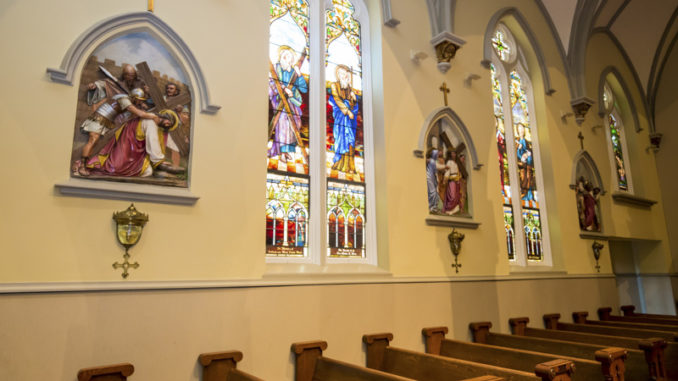
During the 40 days of Lent, there is perhaps no prayer or devotion that better sums up the spirit of the season than the Stations of the Cross. The stations remind us of Christ’s difficult journey to his crucifixion, and of the spiritual journey we should take as we move through Lent.
As we enter the second year of the coronavirus pandemic, Bishop Robert E. Guglielmone encourages people to meditate on the stations as a way to connect with Christ spiritually and emotionally.
What they are
The stations are a series of 14 images which depict the Passion of Christ. The traditional devotion includes meditating on each image and its meaning,and reciting prayers to accompany them.
Depictions of the 14 stations can be found in every Catholic church, usually arranged along the side walls of the sanctuary. The drama of Christ’s Passion is depicted through them in a wide variety of forms, ranging from detailed relief sculptures in stone and metal to paintings that may be detailed or stark in their minimalism. No matter the medium, the message comes through.
How they started
The Stations of the Cross have their roots in the pilgrimages early Christians made to Jerusalem, and they depict stops along the way of the Via Dolorosa, the path that Jesus is said to have walked on the way to Calvary. Many pilgrims would make this walk when visiting the Holy Land.
The stations as we know them today were started by Franciscans in Europe in the 15th and 16th centuries, who built outdoor shrines that depicted stops along the Way of the Cross. Putting stations inside churches became popular at the end of the 17th century, especially because Turkish rule made it difficult for most pilgrims to go to the Holy Land. In 1686, Pope Innocent XI granted Franciscans the right to place Stations of the Cross inside their churches, and in 1731 Pope Clement XII extended the right to all churches and fixed the number of stations at 14.
How to pray them
Typically during Lent, most churches offer communal prayer of the stations, usually led by a priest. He will walk to each station inside the church, describe what occurs there, and lead participants in specific prayers or meditations. The faithful follow along in devotional booklets or programs provided by the church. However, people may also pray the stations on their own with the use of a printed devotional or online devotional.
Pray our interactive stations of the cross here.
Famous stations
Via Dolorosa: The most famous set of stations is the Via Dolorosa, also known as the “Way of Sorrows” in Jerusalem. Pilgrims have prayed at stops along this route since before the eighth century. The Via Dolorosa today includes nine stations that are outside, and five that are inside the Church of the Holy Sepulchre. Franciscan guides lead pilgrims along the Via Dolorosa every Friday during the year, with the largest crowds occurring on Good Friday.
Rome: Each Good Friday in Rome, large crowds of pilgrims take part in a dramatic Stations of the Cross, or Via Crucis, which is led by the pope and takes place at the Colosseum.
Stations to visit in S.C.
Contemplating the Stations of the Cross on your own can be one of the most meaningful ways to reflect on the true meaning of Christ’s passion. Some parishes offer special outdoor locations which combine the beauty of nature with the power of the Way of the Cross.
Way of the Cross Park is located behind Christ Our King Church, 1122 Russell Drive, Mount Pleasant. The park features a lagoon and oak trees with markers depicting the Stations of the Cross. Visitors can visit the park on their own. Stations of the Cross is offered communally in the park on Good Friday.
Holy Family Church in Hilton Head has a Stations of the Cross Walkway located outdoors on the parish grounds next to the Shrine of Our Lady of Guadalupe. The stations are arranged along a boardwalk. The church is located at 24 Pope Ave.
St. Joseph Church, 3512 Devine St., Columbia, offers a beautiful set of mosaic Stations of the Cross done by Columbia artist Angel Allen. They are arranged around the edges of the parish prayer garden near the columbarium.
This article was first published in March 2020.

